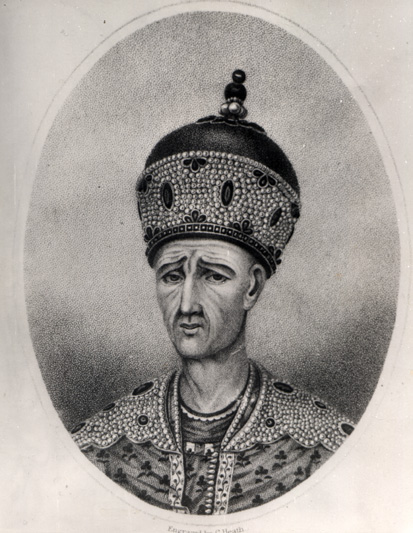<Back to Index>
- Psychologist Erich Seligmann Fromm, 1900
- Composer Carl Gottfried Wilhelm Taubert, 1811
- Shahanshah of Persia Agha Muhammad Khān Qājār, 1742
PAGE SPONSOR

Agha Muḥammad Khān Qājār (1742 - 1797) (Persian: آغا محمد خان قاجار) was the chief of the Qajar tribe. He became the Emperor / Shah of Persia in 1794 and established the Qajar dynasty. He was succeeded by his nephew, Fat′h Ali Shah Qajar.
At the age of six Agha Muhammad was castrated on the orders of Adil Shah to prevent him from becoming a political rival, but this loss did not hinder his career. Despite being a eunuch, he became the chief of his tribe in 1758. In 1762 he was captured by a rival tribe and sent to Shiraz as a prisoner to Karim Khan's court. Agha Muhammad spent the next 16 years as a hostage, until he escaped in 1779. That same year, the death of Shah Karim Khan Zand plunged the country into a series of civil wars and disputes over the succession, with many members of the Zand dynasty acceding to the Peacock Throne in the space of only ten years. Agha Muhammad took the opportunity to launch a rebellion which, in 1794, succeeded in capturing Lotf Ali Khan, the last Zand ruler. Two years later he proclaimed himself Shahanshah (King of Kings). Agha
Muhammad restored Persia to a unity it had not had since the fall of
the Safavid dynasty. He was, however, a man of extreme violence who
killed almost all who could threaten his hold on power. In 1795 he
ravaged Georgia, a kingdom to the north of Persia, which was formerly part of the Safavid empire. In the same year he also captured Khorasan. Shah Rukh, ruler of Khorasan and grandson of Nadir Shah, was tortured to death because Agha Muhammad thought that he knew of Nadir's legendary treasures. In 1796 Agha Muhammad moved his capital from Sari to Tehran. He was the first Persian ruler to make Tehran, then only a village, his capital. Although the Russians took Derbent and briefly occupied Baku during the Persian Expedition of 1796, he successfully expanded Persian influence into the Caucasus,
reasserting Iranian sovereignty over its former dependencies in the
region. He was, however, a notoriously cruel ruler, who reduced Tbilisi to ashes and massacred its Christian population, as he had done with his Muslim subjects. Agha Muhammad was assassinated in 1797 in the city of Shusha, the capital of Karabakh khanate,
after about 16 years in power. Legend has it that at the night of his
death, Agha Muhammad Khan ordered his servants to bring him a melon cut
into slices. He finished half, ordered the other half to be put away
and vowed to his servants, that if even one slice of the melon was
missing in the morning, all three servants would be beheaded by him.
Later on that night one of the servants forgot and ate a slice. The
servants then killed Agha Muhammad Khan with the dagger because they
were afraid he would kill them in the morning. According to Hasan-e Fasa'i's' Farsnama-ye Naseri,
during Agha Muhammad's stay in Shusha, one night "a quarrel arose
between a Georgian servant named Sadeq and the valet Khodadad-e
Esfahani. They raised their voices to such a pitch that the shah became
angry and ordered both to be executed. Sadeq Khan-e Shaqaqi, a
prominent emir, interceded on their behalf, but was not listened to.
The shah, however, ordered their execution to be postponed until
Saturday, as this happened to be the evening of Friday, and allowed
them to go back to their duties in the royal pavilion, unfettered and
unchained. From experience, however, they knew that he would keep to
what he had ordered, and, having no hope, they turned to boldness. When
the shah was sleeping, they were joined by the valet Abbas-e
Mazandarani, who was in the plot with them, and the three invaded the
royal pavilion and with dagger and knife murdered the shah."